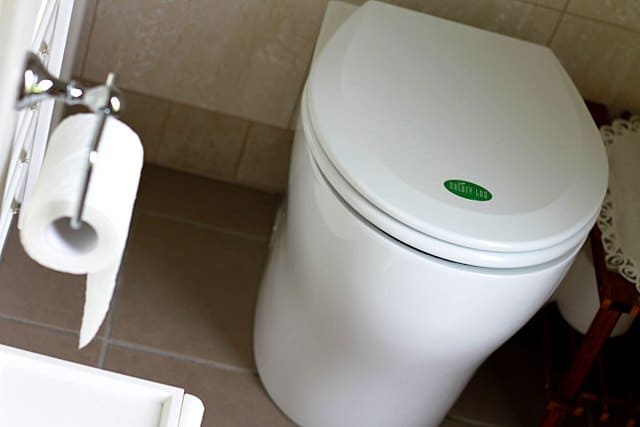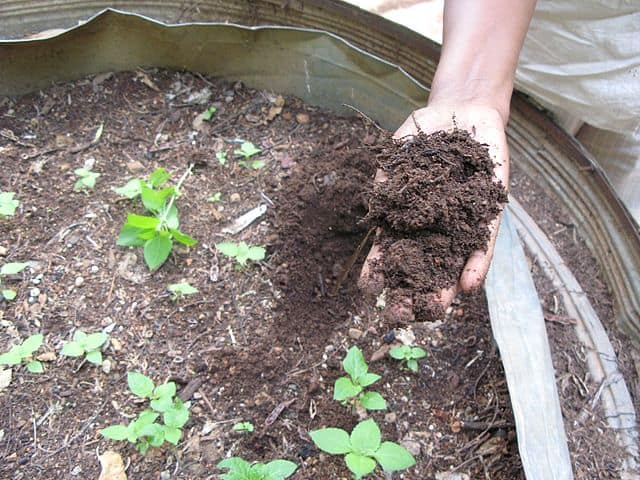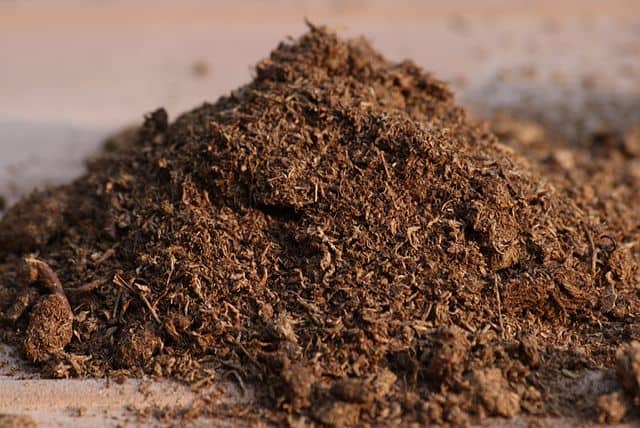They say public speaking is the number one fear, but I’ll bet composting toilets are a close second.
Women who don’t sneeze at wiping a baby’s bottom for three years squeak at the very idea of handling grown-up waste. Grown men who use railroad spikes for toothpicks and punch telephone poles with their bare knuckles cringe at the phrase “stir your poop.”
It’s hardwired into our psychology, I suppose. So let me be the one to tell you: Composting toilets aren’t gross. In fact, a good composting toilet is way less icky than the nasty effluent you drain out of your RV waste tank every summer weekend.
I’ve used composting toilets. I’ve installed them. I even built a cheap DIY bucket one, once (more on that later).
Why Would Anyone Want a Composting Toilet?
Travelers are normally interested in composting toilets for one of three reasons:
- They love the earth and want to do their part
- They want to camp off-grid for an extended period
- They’re tired of the RV Stinky Slinky and want less “yuck”
By the way, if you’re still wielding the Slinky, here’s our advice how to get rid of those pesky tank odors!
Reason No. 2 is probably the most popular. Composting toilets use no water and fill up more slowly than a traditional waste tank of a similar size.
The two RV owners at Drivin’ and Vibin’ wrote a whole article on their composting toilet experience. I highly recommend the read! They enjoy being able to camp off-grid for 14 days, but if they had to pick, they’d choose a flush-and-forget toilet.
Jason and Nikki at GoneWiththeWynns also use a composting toilet – on both RV and sailboat! They’ve used the Nature’s Head toilet for over four years. They’re big fans.
Composting toilets are a great water-saving sanitation solution for full-time RVers, boondockers, and even weekend warriors. They don’t smell, don’t use water, and almost anyone can install one in their RV or camper!
Do RV Composting Toilets Smell?
No, a maintained composting toilet does not smell bad.
Really.
I know you don’t believe me, so keep reading. I’ll explain. There are four reasons why a composting toilet does not normally smell.
1) Venting
The solids container of a composting toilet is vented to the outside, just like the vent pipe from a traditional waste tank! Odors don’t even have the chance to build up. And most composting toilets employ a small 12V fan to ensure ventilation.
2) Breakdown
Poop doesn’t want to stay poop, people. It wants to become humus (not hummus, the delicious chickpea spread. You don’t want to confuse those two). I hesitate to compare the decomposition cycle to a caterpillar metamorphosing into a butterfly, but you get the idea.
Composting toilets create a conducive environment for microbial waste breakdown. With a little moss and sawdust, heat, and oxygen, human waste breaks down very quickly.
3) Cover
A cat box uses litter made from corn, newspaper, or bentonite clay to absorb liquids and cover up solid waste. Composting toilets are designed around a similar idea.
But rather than using clay litter to hide the scent, composting toilets typically use peat moss, wood shavings or some other carbon-based cover and bulking material. You’d be amazed how little sawdust is necessary to eliminate the No. 2 smell!
4) No Urine
You’d be forgiven for thinking that the worst smell in a toilet came from the poop, but actually, it’s the urine that causes problems. As urine dehydrates, the ammonia becomes concentrated, and that’s not a smell you’ll soon forget.
Dry composting toilets separate the liquids from the solids. The liquid is kept in a sealed container, which eliminates any long-term smell from the liquid waste. You’ll empty the urine container every few days to every week or two.
“So … What Does It Smell Like?”
Now, composting toilets do have a smell. The completed compost smells earthy, rich, a little sweet. Like farmland. Not a dairy farm (that’s gross). More like fertilized cropland from Amish country. While it takes years to fully compost human waste to eradicate all the potential pathogens, the bulk work is completed in only a few weeks.
It sounds crazy, I know. But a composting toilet isn’t just a bucket full of feces. It’s an engineered product that leverages the power of microbial chemistry to decompose human waste into something totally different.
How Does an RV Composting Toilet Work?

Ye Olde Standby: The Gravity Toilet
If you haven’t already read my article about the common RV gravity toilet, head over. If you’re on lunch break and don’t have time to read the full article, here’s the basic scoop:
A gravity toilet sits on top of a waste tank. All waste, solid and liquid, gets flushed down the toilet tube and drops into the tank. When you open the dump valve, the waste flows out. A vertical pipe vents the odor to the outdoors.
It’s inelegant but simple. And understanding the typical gravity toilet will help you understand the differences between an RV toilet and a composting toilet.
The Modern Alternative: Waterless Composting Toilet
The Basic-How-To Stuff
Your typical RV composting toilet is a self-contained, diverting waterless toilet + holding tank.
In terms of the “user experience,” not much is different. You use the throne as usual – but everyone must sit down! That includes you too, gentlemen!
After you use the premises, you crank a handle, toss some bulking material in the bowl, and walk away. As my brother likes to say, “It’s one of the few times you can do more on empty.”
While you’re gone, Mother Nature does the rest.
- Every 2-5 days, you’ll empty the urine container into a regular toilet.
- After several weeks – maybe even a few months – you empty the compost into an approved container, usually just a regular trash can. (More on waste disposal later.)
It’s not a flush-and-forget system. You can’t throw any old thing down there: feminine hygiene products, goldfish, etc. You can throw approved toilet paper in the toilet. You don’t need to put your dirty toilet paper in a separate container. That’s a common myth.
After use, you should spritz the bowl with a water and white vinegar solution to wash off any residue or streaks.
For commode-specific details, you should read your User Manual.
- Nature’s Head User Manual (click here)
- Sun-Mar User Manual (click here)
- Air Head User Manual (click here)
The Science-Y Stuff

Composting toilets decompose human waste into compost, a dirt-like substance chock-full of beneficial bacteria and nutrients.
You might be wondering, “What’s the difference between compost and dirt?” Well, compost feeds soil, and soil feeds the plants.
With the right ingredients, Mother Nature – with a little accelerated help from mankind – can transform hazardous human waste into a killer fertilizer. Here are those five ingredients (but let’s not get too technical).
- Nitrogen: For our purposes, all you need to understand is that your poop supplies the nitrogen necessary for the composting system. There isn’t a lot of nitrogen in your stools – it’s mostly water and fiber – but there’s enough!
- Carbon: Carbon is the basic building block of, well, almost every living thing on earth. In a composting toilet, carbon is usually added with sawdust, peat moss, sphagnum moss, coco pith, or a combination thereof.
- Oxygen: Decomposition is an aerobic process. That means it needs oxygen! Not a lot, but a little goes a long way. The mixture needs little air pockets to feed the microbes
- Moisture – but just the right amount! Generally, you don’t add moisture to a composting system. Poop is already about 75% water.
- Heat: Composting is a thermophilic (that means heat-loving) process! Cold compost just kind of sits there. Warm or hot compost (somewhere around 113 degrees Fahrenheit is optimal) works hundreds of times faster.
So long as all these ingredients and conditions are present in the right amounts, you’ll get good composting.
However, you need just the right ratio of carbon to nitrogen in a compost system! In fact, a 25:1 ratio of carbon to nitrogen is just about perfect. Too much carbon, and you won’t get much decomposition. It’ll just sit there. Too much nitrogen, and the stink will drive you out of your camper (more on this later).
References for Your Pleasurable Reading
*Psst … If you’re curious about what poop is made of, I found a great infographic here! And if you really want to learn about this stuff, you can’t start anywhere better than the Humanure Handbook. These guys are serious. They literally travel to disaster areas to teach people how to build and use composting toilets!
How Do I Empty an RV Composting Toilet?

Short answer: Composted waste can be placed in the municipal solid waste (MSW) system – in other words, almost every public trash can. Sounds weird, but that’s where diapers go!
That’s NOT true for the effluent out of sewage tank! For more details on how to empty portable RV waste tanks, read this.
Usually, the waste should be partially composted, fairly dry, bagged, and less than 5 gallons.
Long answer: I have a confession: Composting toilets don’t actually compost your waste – not all the way, anyway. They start the process, but they don’t usually finish it.
True composting requires time. The “compost” you get after a 30-day waiting period is still, to some degree, poop. It won’t smell or look like poop, but you wouldn’t want to spread it in your garden. Or any potted plants.
And most definitely DO NOT dump it in the woods! You are not participating in the Great Circle of Life. You’re potentially spreading E. coli and dangerous pathogens.
Destroying pathogens in composted waste requires both heat and time. Composting can take place in thermophilic (high heat) and low temperature (mesophilic) conditions. The higher the heat, the shorter the time it takes.
Compost in an RV toilet never really gets hot enough to kill pathogens. It could take a looong time – up to 2 years! – at ambient temperatures before the composting cycle is complete.
Ching and Jerud at Live Small Ride Free wrote an excellent article answering this question, too. Check it out here!
P.S. If you’re a serious home composter, you may have a backyard composting pile to which you can add your waste. You’re way beyond the scope of this article, though!
What Should I Use in My Composting Toilet?

Almost all composting toilets are dry or waterless toilets. Urine is diverted into a separate container, leaving the solids – which are still mostly water – behind.
By itself, poop and water make sewage effluent, which is the stuff of nightmares. So users commonly add a carbon-based bulking agent.
A bulking agent serves several purposes:
- Adds carbon to the system for faster, better bacterial breakdown
- Creates air pockets in the mixture, trapping oxygen that feeds the aerobic bacteria.
- Covers the waste and masks the smell.
- Absorbs stray liquids.
Composters have experimented with many bulking materials. Here are some of the most popular:
- Peat moss: An organic moss, usually decaying sphagnum, harvested from acidic peat bogs. Peat moss is a limited natural resource, so it should be used in limited quantities.
- Coco pith: A fiber extracted from the processing of coconut husk. This is rapidly becoming a popular substitute for peat moss.
- Wood shavings: Large, curly-cue shavings from almost any wood species – except cedar and other woods naturally high in tannins – make excellent cover material.
You can – and probably should – purchase these materials commercially. Many manufacturers blend these ingredients, and a few others, to create bulk mixtures on steroids.
Contrary to what you may have heard, sawdust alone isn’t a good cover material. It’s too fine. You won’t get enough air pockets, and you’ll drastically slow the waste breakdown (ask me how I know).
NEVER use fertilizer! Or any topsoil or anything with fertilizers added! It’ll get super gross. You’ll be growing a garden of questionables inside your toilet. Don’t do that.
What Are the Pros and Cons of a Composting Toilet in a Camper?
PROS
No More Stinky Slinky!
Having dumped both composting toilets and RV waste tanks, I can vouch for the composting toilet. It’s way less icky. You don’t have to keep a special sewer hose, special black tank rinse hose, and special dump-day gloves on hand.
As a bonus, compost can normally be disposed of in the public municipal solid waste (MSW) system – in other words, almost every public trash can. Sounds weird, but that’s where diapers go!
Use It Anywhere!
A dry composting toilet is a self-contained system. No dump site needed. Anywhere you can haul it, you can use it: Campground, tent site, boondocks, your backyard, Sprinter van, 8-hr long-haul cross-country road trip, you name it.
Eco-Friendly
Composting is the most natural process in the world! It’s Mother Nature’s recycling program. In fact, even effluent in the sewage system may be pumped into vermicomposting trenches or pumped into wetlands where plants and sediment filter and clean.
No Chemicals
Unlike a traditional black tank, you won’t be adding packets of questionable chemicals to your composting toilet!
Psst … we have some ideas ourselves how to clean out a blank tank. Read advice from a full-time here.
No Water Added
Popular composting toilets are waterless (aka dry). No fresh water is added. You can take more showers, wash more dishes, and drink more water while camping.
CONS
Upfront Cost
Let’s be honest: Composting toilets are expensive. Expect to spend $750 to $1,500 for a retail unit (and this isn’t a time you want to buy used!).
If you’re installing the toilet in your RV, add some more dollars for materials to properly convert your bathroom: exhaust pipe, wall cover, sealant, etc.
Guest Training
You kinda have to train your guests how to use a composting toilet. Thankfully, the manufacturers have helped you out!
In the sidebar, Nature’s Head has a link for a downloadable PDF showing guests how to use the composting commode.
Group Size Limited
The less you use a composting toilet, the better it works: the longer the waste can break down. If you regularly host large groups of people, or you’re full-timing with a family of six, you may find that a single composting toilet can’t quite handle all the “deposits.” Rather than dumping compost, you’ll be dumping … well, you know.
As a rule, the bulk of the waste should be at least 10-14 days old before handling. Not that you can’t dispose of it sooner! It’s just closer to the original thing than what you may prefer.
Thin Toilet Paper
Composting toilets work best with thin (1-ply) toilet paper. I know everyone hates the thin stuff, but it’s true.
Can I Build My Own Composting RV Toilet?
There are three major brand names for RV composting toilets:
- Nature’s Head
- Sun-Mar
- Air Head
Of those three, I’ve used the Nature’s Head. It worked well. I haven’t used the other two. Nature’s Head is often recommended as the best composting toilet for RVs.
Now, I did try building my own, once. It was a … learning experience. Let’s just say I learned the proper chemistry on the fly. Speaking of flies, if you build your own, you have to consider stuff like how to keep the flies away …
See, a 5-gallon bucket with some wood shop sawdust is what most people imagine of a composting toilet. A bucket toilet is a composting toilet reduced to its skeletal elements: a container, poop, sawdust, and some moss or coco pith. Thankfully, see above for better options!
To be honest, I don’t recommend the DIY strategy. You need an in-depth knowledge of manure composting to troubleshoot problems. Add too little cover, forget to aerate – or aerate too much – and you might end up with a wet, squelchy pile of s**t.
If you’re determined to forge your own path, do your research. Design a ventilated system. Install a thermometer. Study the Humanure Handbook. Use the right size wood shavings and coarse peat moss.
Leave a Reply